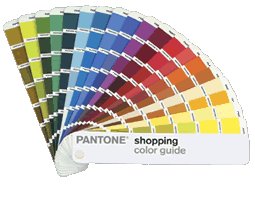 Last week I bought a Pantone Color Guide and it’s amazing how useful it is. Savvy fabric websites like Emma One Sock and Gorgeous Fabrics already use Pantone color numbers in their fabric descriptions, and I hope this becomes a standard for all fabric and sewing trim websites (are you listening, M&J Trim and Fabric.com?) I love on-line fabric shopping, but frankly, for fabric selection you should not trust the colors displayed on your monitor, especially for reds and blues, which have a huge range of color, saturation and hue. It’s so much easier to be confident of a color when you can look it up in your Pantone Guide to really get an accurate sense of what it looks like. The Pantone Shopping Color Guide ($19.95) is the version you want, other Pantone color decks are pricey ($100+) and are really intended for design professionals. Once caveat: Pantone seems to hide this on their web site, and will ship it only within the US and Canada. Els asked me to get one for her, and the shipping to Europe ended up being more than a third of the price, so I suspect that’s why this is a US/Canada only item on the US Pantone web site. Pantone’s color system is a global standard however, I googled “Pantone UK” and “Pantone Germany” and got web sites for each, so with some perseverance you might find this outside the US.
Last week I bought a Pantone Color Guide and it’s amazing how useful it is. Savvy fabric websites like Emma One Sock and Gorgeous Fabrics already use Pantone color numbers in their fabric descriptions, and I hope this becomes a standard for all fabric and sewing trim websites (are you listening, M&J Trim and Fabric.com?) I love on-line fabric shopping, but frankly, for fabric selection you should not trust the colors displayed on your monitor, especially for reds and blues, which have a huge range of color, saturation and hue. It’s so much easier to be confident of a color when you can look it up in your Pantone Guide to really get an accurate sense of what it looks like. The Pantone Shopping Color Guide ($19.95) is the version you want, other Pantone color decks are pricey ($100+) and are really intended for design professionals. Once caveat: Pantone seems to hide this on their web site, and will ship it only within the US and Canada. Els asked me to get one for her, and the shipping to Europe ended up being more than a third of the price, so I suspect that’s why this is a US/Canada only item on the US Pantone web site. Pantone’s color system is a global standard however, I googled “Pantone UK” and “Pantone Germany” and got web sites for each, so with some perseverance you might find this outside the US.
January 25, 2009
True Colors: Don’t Trust That Monitor
January 21, 2009
Freedom
Cidell asked me what I thought of Aretha’s hat. Well this is why it was such a stunning choice. Now just imagine that you are in the audience at this momentous occasion. Imagine what those huge (12mm) Swarovski stones look like in the bright winter sun. Imagine being so far away that you can’t actually see her, but you can hear that voice and the rhinestones are flashing in your eyes while she’s singing. You cry because they are so bright and it hurts but also because of the emotion in the moment. Aretha was the Statute of Liberty, her brilliant hat was her crown and the microphone was her torch.
January 20, 2009
Green Gloves
Worn with a delicate light green guipure wool lace coat and matching dress by Isabel Toleldo. Some news sources have reported that Michelle’s outfit was yellow, but I think its really a yellow green; and besides who would wear green gloves with a yellow lace coat? Isabel Toledo is one of my favorite designers, and this ensemble is different for her, she generally has that sharp Spanish style of tailoring, this coat and dress being softer than her usual work; this looks almost Chanelish. Given the bitter cold on the east coast right now, the First Lady stayed warm with a coordinating cashmere scarf and a cardigan with a lovely diamante collar. Sublime.


January 17, 2009
Your Very Own John Galliano
If you follow this link, you can download this pattern for John Galliano’s Pirate Jacket from his 2001 collection. The site also has a gallery of examples that sewers have made (I really like this green one.) The SHOWstudio site is also some great background on the jacket and its place in his collection. Natually I had to download a copy; I’ll never wear this (DD might) but this design is worth saving because the pattern PDF appears to be the actual oaktag cutting templates, and they are covered with hand written construction notes.
Be warned however; the
 re are 60 pattern pieces. And only one size.
re are 60 pattern pieces. And only one size.
January 13, 2009
Vogue 1073 – Chado Ralph Rucci, Parsing the Pattern Pieces

Here is a photo of the center front piece pinned to my dressform; as you can see, the darts wrap around the body and they are hidden in the tucks.
Last night I cut out my pattern and began to study it in more detail, but first let me share with you some interesting information I received today about how this dress is constructed. Gail (who is certainly in a position to know) has confirmed that the construction method I’m investigating for the pin tucks is correct. She also offers more insights into the tucks that I’ll excerpt for you:
“…. I thought I’d offer some comments to let you know that you are on the right track. I have not seen the commercial pattern that you are working with, but I can tell you how the samples are made in the (Rucci) workroom. The pattern allows 3/16″ for a 1/8″ pin tuck. You are constructing the pin tucks correctly, and you are right, there is no stabilizer or cording in the pin tuck. The knit that was used for this dress is not jersey, it is actually interlock, which is a different knit construction. If you are a knitter, you will recognize jersey as having a flat side and a bumpy side, like stockinette stitch. Interlock is a double knit construction, it makes a beefier, more stable cloth, it is flat on both sides…. “
Needless to say I panicked and immediately inspected my sample to determine the type of fabric I have, and this wool knit is indeed interlock, albeit one that is very lightweight, but it does have the stability that Gail references. Whew.
So now we know that Vogue’s fabric recommendation is wrong: you need wool interlock, not wool jersey. It also must be 60 inches wide because the front needs to cut single layer (and I suspect this is also why Vogue does not offer this pattern graded higher than Size 16.)
Now that I know the exact fabric this design requires, I need to hit Jo-Ann’s to find an inexpensive interlock to use for muslins, which brings me to my pattern observations.
After giving it some thought, I cut off the seam allowances because I’ve decided to thread trace the pattern seam allowances onto blocks of fabric in a single layer layout. Why? Because that’s how it’s done in haute couture, and also because basting the pin tucks by hand onto flat laid fabric will require a single layer layout anyway. The seam allowances also just made it too difficult see the finished lines of this dress
A quick observation on petite and FBA adjustments in general:
- I’ve decided to go down one size to a 12 for the 1stmuslin. Vogue slopers have linebacker shoulders, and I have narrow shoulders.
- This dress really hangs from the shoulders and bust. Fortunately, the shoulders and sleeves are simple, there is no set in sleeve, just a kimono-like shoulder with a single seam that runs runs down the top of the arm from the side neck to the wrist. Ease is supplied by the knit fabric and under arm gussets. To determine your own size match the pattern as closely to your bust size as possible because the skirt portion is a very simple A-Line shape that skims the body and will be easy to alter; the fit through the bust however is crucial.
Next post I’ll pin the upper bodice front and back to my dressform so you can see how those pattern pieces relate to the body.
Thank you Gail! To say I was a little verklempt when I read her comment is putting it midly. You can read all of Gail’s comment here (scroll to comment 16.)
Next post: How I’ll tackle the muslin and more photos of the pattern pieces.



 Subscribe with Bloglines
Subscribe with Bloglines